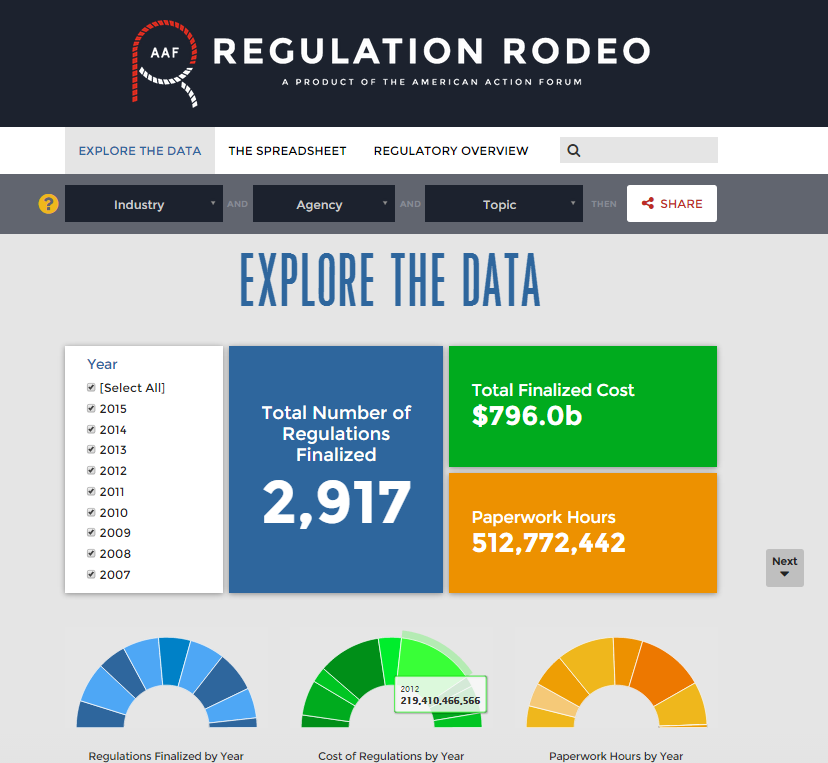To many, the world of regulation is a black box. Generally, the public is supportive of individual regulation, but critical of the unchecked accumulation of rules. The problem is that we generally don’t know the overall costs and benefits of federal rules. Now, with a new tool, we can examine every regulation that has a cost or imposes paperwork burdens.
Previously, those curious about regulatory costs were often directed to the administration’s “comprehensive” report to Congress. Pretending to represent the “vast majority” of all regulatory costs and benefits, every administration would trumpet the success of its executive actions providing billions of dollars in net benefits for the American people. However, this report only captured less than one percent of all federal rules issued in a given year.
To provide more scrutiny, a new website by the American Action Forum (regrodeo.com) allows users to view the costs and paperwork burden hours by agency, year, industry, and by law (Obamacare and Dodd-Frank).
For example, we’ve heard endless streams of talking points on the benefits and the costs of Obamacare. With this new tool, we can easily say the regulatory costs will exceed $42 billion, with more than 155 million paperwork burden hours. The paperwork figure represents the time that Americans will spend filling out more health care forms and tax paperwork. For perspective, 155 million hours equals 17,694 years worth of regulatory compliance. Or, it’s equivalent to 77,500 employees working full time for a year filling out Obamacare paperwork. To say these burdens are a drain on resources would be an understatement.
Beyond the health care law, regrodeo.com offers users the ability to explore Dodd-Frank, what is now being dubbed “Obamacare for Banks.” The burdens here too are staggering: $20 billion in final costs and more than 59 million paperwork burden hours. For the average consumer, expect the upfront cost of a mortgage to increase by $350, thanks to a rule from the Consumer Financial Protection Bureau and four other regulators.
The time data show that regulators imposed the most burdens in 2010 and 2012: $179 billion and $219 billion. The 2012 figure is amazing because the White House deliberately delayed certain regulations in an effort to lower the compliance burdens during an election year. According to several outlets, the administration delayed health care laws and an EPA rule that will raise the price of gasoline. The administration waited until after the election and finalized the rule last year, imposing $14.5 billion in total costs.
2010 might have come in second place, but it has several records to its credit. According to the Government Accountability Office (GAO), 2010 set a modern record by imposing 100 “major” regulations, those with an economic impact of $100 million or more. By contrast, last year was relatively tame, with regulators imposing a mere 80 major regulations.
The most expensive agency, the Environmental Protection Agency, won’t be a surprise to many. However, the silver medal winner, the Department of Energy, has quietly imposed $164 billion in regulatory costs, from just 44 final rules that monetized costs and benefits. It took EPA 180 rules to get to $317 billion in costs and more than 19 million paperwork burden hours.
What do these huge numbers mean for average people? Higher energy prices: EPA estimates just three of its recent regulations will raise electricity prices by 10 percent by 2020. Higher vehicle prices: new CAFE rules will raise the price of an average vehicle by more than $3,000. In the market for a new dishwasher? A new proposal could raise the price by roughly $100.
It is AAF’s hope that regrodeo.com serves as a helpful resource for anyone interested in what our federal agencies are doing. Currently, AAF has nine years of data and the site will be updated regularly in an effort to peer inside the world of regulation to examine what is often unseen in federal policy.


